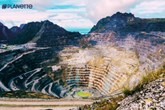Decarbonising the depths: How mining is tackling Its 2030 climate targets
Published by Jody Dodgson,
Editorial Assistant
Global Mining Review,
The global decarbonisation movement places the mining industry at a decisive juncture. The sector fuels and relies on resource-intensive processes, yet the 2030 deadline marks a crucial milestone for change. How are miners positioning themselves for success in the face of the industry’s negative environmental impacts and its long history with fossil energy?
Mining's carbon footprint against the 2030 pressure point and growing demand
Mining’s emissions profile is shaped by a combination of direct and indirect sources tied to extraction and processing. The global metals and mining sector is responsible for around 8% of the worldwide carbon footprint.
Despite its critical role in the energy transition, the industry’s pace of decarbonisation remains slow. It averages only a 2% annual emissions reduction, about half of what’s required to align with the 1.5 degrees Celsius pathway. Without faster progress, mining operations risk falling short of greenhouse gas reduction goals by nearly 40%.
Demand for critical minerals essential to decarbonisation complicates progress. The energy sector has tripled its lithium needs since 2017, while cobalt and nickel requirements have risen 70% and 40%, respectively. By 2030, current mines may only supply half the cobalt and lithium the world requires.
Key pathways to a net-zero future
Creating a climate plan takes work, but waiting is not an option. A multi-pronged approach can best aid ambitious goals.
From divestment to transformation
Most emission cuts so far have come from asset divestments, not operational changes. The next phase demands electrified fleets, green microgrids, process heat electrification and data-driven energy control. In Australia, Agnew now sources up to 60% of its power from renewables through hybrid solar and wind systems. With truck haulage responsible for up to 50% of emissions in open pits, more companies are shifting to battery-electric or trolley-assisted fleets.
However, full electrification introduces new dependencies on power reliability and outages, which are more frequent as extreme weather disrupts grids, pose real risks to production continuity and long-term energy stability.
Policy alignment and national strategies
Policy frameworks are tightening across major resource economies. In South Africa, the Climate Change Bill and Just Energy Transition Plan establish emissions targets and carbon budgets for the mining sector.
However, coal still provides 70% of power, and grid reliability limits deeper cuts. Fiscal and regulatory tools, like the Carbon Tax Act and Sustainable Finance Taxonomy, direct capital toward low-impact technologies. This signals a broader shift in which governments drive transformation through financial incentives and accountability, rather than extraction limits.
Technology and capital as decarbonisation drivers
Leading organisations are adopting internal carbon pricing to factor in emissions costs, supporting investments in renewables, electrification, and digital tools. Digital twins optimise haul cycles and cut idle emissions, while electrified fleets reduce diesel particulates and ventilation energy use. Collaboration between governments, investors, and miners is driving demonstration projects that show large-scale decarbonisation is achievable without sacrificing production efficiency or ore quality.
The road ahead for a sustainable mining sector
The path to net-zero mining is complex but increasingly quantifiable. The tools are available, and the policy groundwork is in place. The challenge lies in expanding and adopting these solutions quickly enough to meet rising resource demand while preventing a surge in extraction-related emissions.
Read the article online at: https://www.globalminingreview.com/mining/20102025/decarbonising-the-depths-how-mining-is-tackling-its-2030-climate-targets/
You might also like
The dual threat facing modern mining
Extreme weather is reshaping mining – driving floods, drought, and costly disruptions. Long-range environmental forecasting offers a path to safer operations, stronger infrastructure, and planning amid a rapidly intensifying water cycle.


